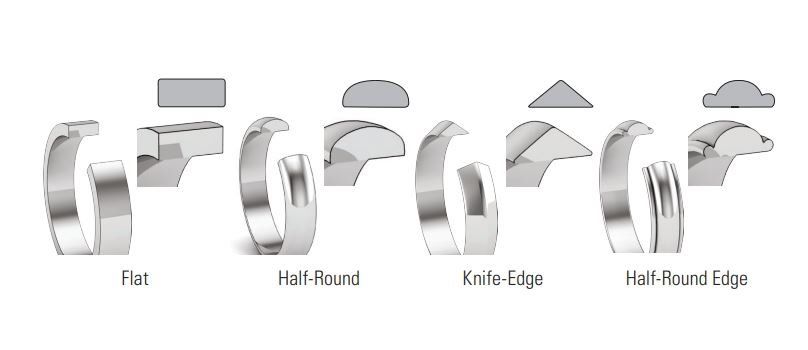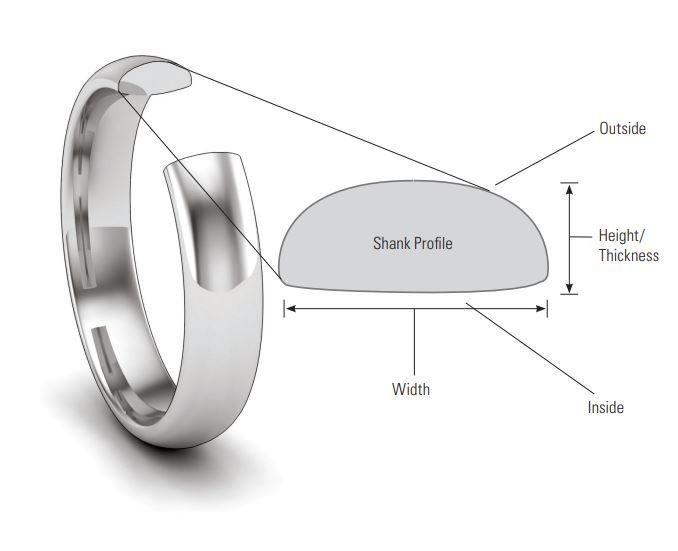Peninsula Gem & Jewelry Supply
RING TERMINOLOGY
Accent Stone - The smaller gemstones in a ring that are used to compliment or enhance the main stone.
Bridge - The underside of the band that is directly beneath the head (not all rings have a bridge)
Center Stone - The main stone of the ring, often the largest gemstone of the piece.
Gallery - The part of the head underneath the center stone, visible when the ring is in profile; it may be plain or have filigree, engraving or accents stones. (not all rings have a gallery)
Gallery Rail - Cross beam of metal that keeps the prongs on the sides of the stone in place. (not all rings have a gallery rail)
Head - The piece of metal that holds a gemstone, but is also connected to the band of the ring, also referred too as a Setting. Included in the head are the prongs or bezel, the gallery, and the gallery rail.
Prong - The bit of metal that grabs the stone and holds it in place; prongs come in different styles and amounts depending on the ring.
Mounting - The whole ring itself, not including any gemstones.
Eternity Set - When stones are set completely around the band of the ring, this cannot be sized.
Semi Set - When stones are set halfway down the shank of the ring.
Shank - The band portion of the ring wraps around underneath your finger.
Shoulder - The top part of the band on either side of the head (just like the shoulders of a person).
Side Stone - A gemstone directly adjacent to the center stone, often smaller in size (sometimes "side stone" term is used as well as the "accent stone" term).
Sizing Area (Base) - The base of the shank where ring sizing will occur; this is important to consider when having patterned, eternity, or tapered bands resized.
Tips - The ends of the prongs that actually touch the stone; a common ring repair is re-tipping to maintain gemstone security.
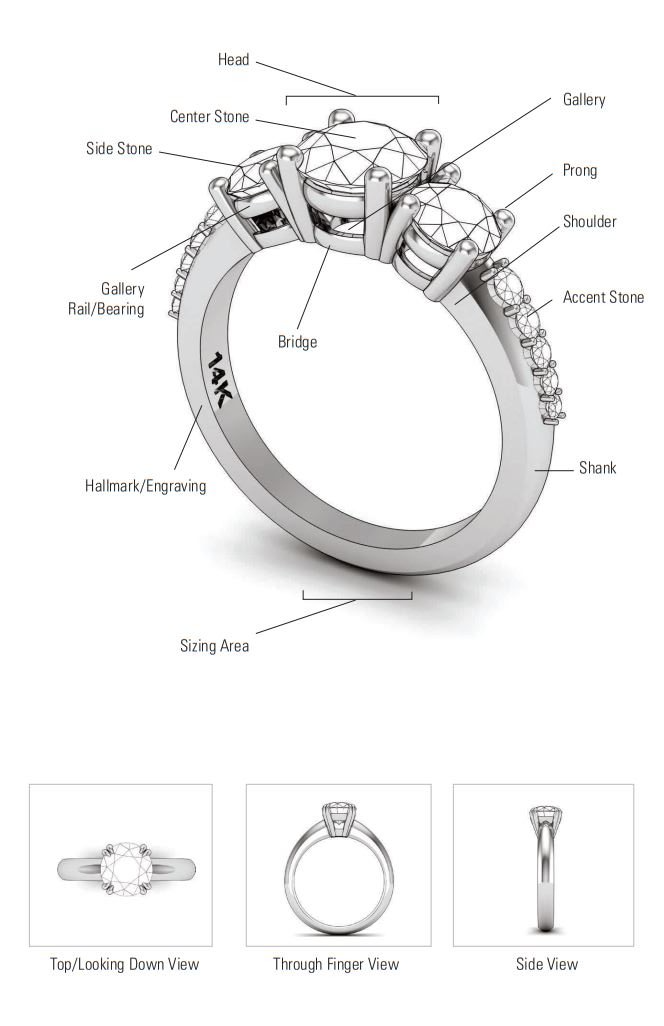
There are many components to consider when buying or creating a ring. Shown above is a diagram of a "classic" engagement ring. Choosing a ring style depends on personal preference. Keep in mind when deciding on a bridal set, that the engagement ring and matching band are usually created to complement each other. Depending on the set, there may be gaps between the ring and the band. Most rings feature a Center Stone held by a setting often referred to as the Head. The center stone can be accompanied by Side Stones, these are stones that are set right next to the center stone, whilst the Accent Stones are either set on the Shoulder and Shank of the ring.(as shown in this diagram, the term side stone and accent stones is an interchangeable. In the image shown, all are held into the setting with pieces of metal called Prongs. There are various types of prongs, and other setting styles that are also used to hold stones, such as v-prongs or bezel settings. We go over styles of prongs on this page as well what goes into repairing them in our repair section. Below the center stone is the Gallery, which is the part of the head underneath the center stone, visible when the ring is in profile; it may be plain or have filigree, engraving or accents stones. It can also be left open as shown in this diagram. Bridge with engraving or some other design on it. The Gallery Rail is another part that can be decorated with stones, filigree or engraving. On the inside of the ring, you have the Hallmark, which can be a karat mark or the actual name or logo of the person or company that made the ring. It is popular to engrave a note on the inside of the ring band as well, if you plan on this make sure you do not plan on sizing the ring, as the engraving would usually be done where the Sizing Area is at the bottom of the ring shank and if sized down or up would ruin the engraving and would have to be polished down and redone. The ring in this diagram would be considered a 3 stone prong set ring with a graduated accent stones and a half round shank.
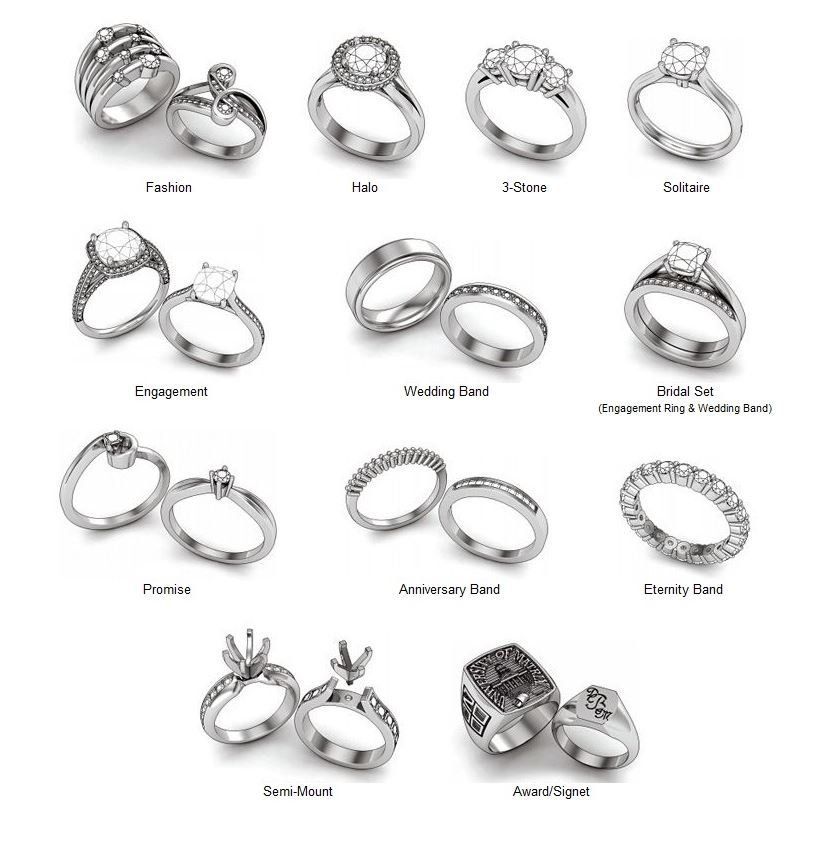
Setting Styles
The top row of the above below shows 3 different kinds of Prong settings. The first is the classic,
Basket setting. There are 4 (sometimes 6 or 8) prongs supported by a ring or two of metal for added support. The second is a Peg Head. These settings tend to stick up higher off the rest of the piece and sits right on top of a shank for what we call a "Cathedral" mounting. The third is a decorative mounting. This type of prong setting can have any number of prongs, but is paired with a design, rather than the basket or the peg.
The second row shows two types of bezel and tab settings. A Bezel means that metal goes all the way around the stone. This is the most secure type of setting. The Partial or Semi Bezel cuts about half of the metal from opposing sides to better show off the stone. This is often a great idea for gemstones to help let more light into the stone. The last is a Tab or Bar Setting. This is typically a straight line of metal that holds in a stone, similarly to a bezel. Where there are multiple of these settings in a row, it is called a Channel Setting.
The third row are alternative prong-like settings. The first is a Bright Cut. the edges of the surrounding metal are given a high polish to make the stone appear larger. The stone is also set lower to better protect the stone. The center setting is a diamond accented setting, similar to the basket setting. The bezel set accent stone adds support to the setting, as well as adding a bit more bling to the profile of the ring. The far right setting is an Illusion Setting. Similarly to the bright cut setting, this setting is made to make smaller stones look larger than they are. These are often found in antique rings.
On the last row, you will see another example of a channel set ring. In this case, it can also be called a Tension Setting. Many tension set rings don't have any metal under the center stone and are held in by the two opposing sides of the shank, giving the illusion of the stone floating in the band.
A Trellis ring is composed of swooping and overlapping wires that make up the "trellis". This designs is most often used in three-stone settings.

Styles and Profiles of Ring Shanks
There are an array of different styles and profiles when it comes to the shank of your ring, the band which encircles your finger. The two basic shank styles are Traditional and Euro- Style. The two most popular shank profiles are . The inside of the ring along the finger is generally either designed to have a curved comfort fit or straighter flat fit, also known as a standard fit. When working with your reputable jeweler, be sure to discuss the desired shank depth and width as well as the profile and inside fit. The shank can be the same thickness all the way around or it can be thicker closer to the top of the setting, this is what is referred to as the shoulders of the ring. Depending on the design of the ring, the shoulder area may taper, widen, split, cathedral, bypass the stone or be freeform as shown below.
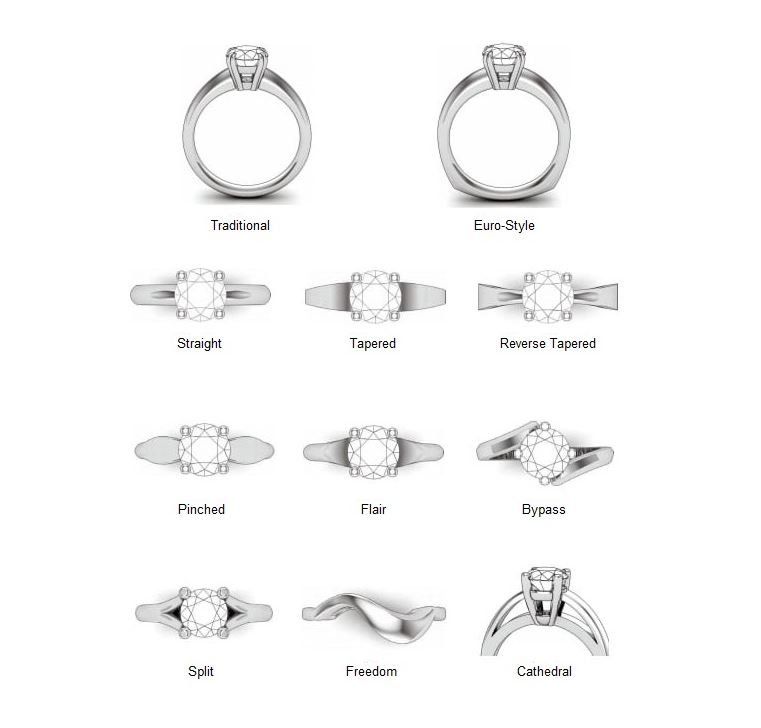
Setting Styles on the Shank/Band
Shown below are some of the ways stones can be set into the shank of your ring. The most common setting is Prong or Bead setting, but depending on how you want the tones to sit or look, can be achieved with different settings. For example, if you want the stones to be flush with the ring, you'd have the option of a setting like a Channel or a Flush setting. If you need more bling that is a possibility as well with a setting like Pave. The complexity of the shank can lead to problems down the line if if needs repair, always think, that the more stones, the more prongs and little parts that eventually will need repair. Sizing is another thing to consider when thinking about shank styles, for example, the Euro style shank we do not recommend sizing as it will alter the look of the ring, how many stones and how they are set can affect if a ring can be sized or not.
A good rule of thumb is if a ring has stones set halfway down or more on the shank, it may lead to problems, a simple solitaire or 3-5 stone setting can usually be sized, depending on the setting. We do not recommend getting any ring sized up or down over one size.
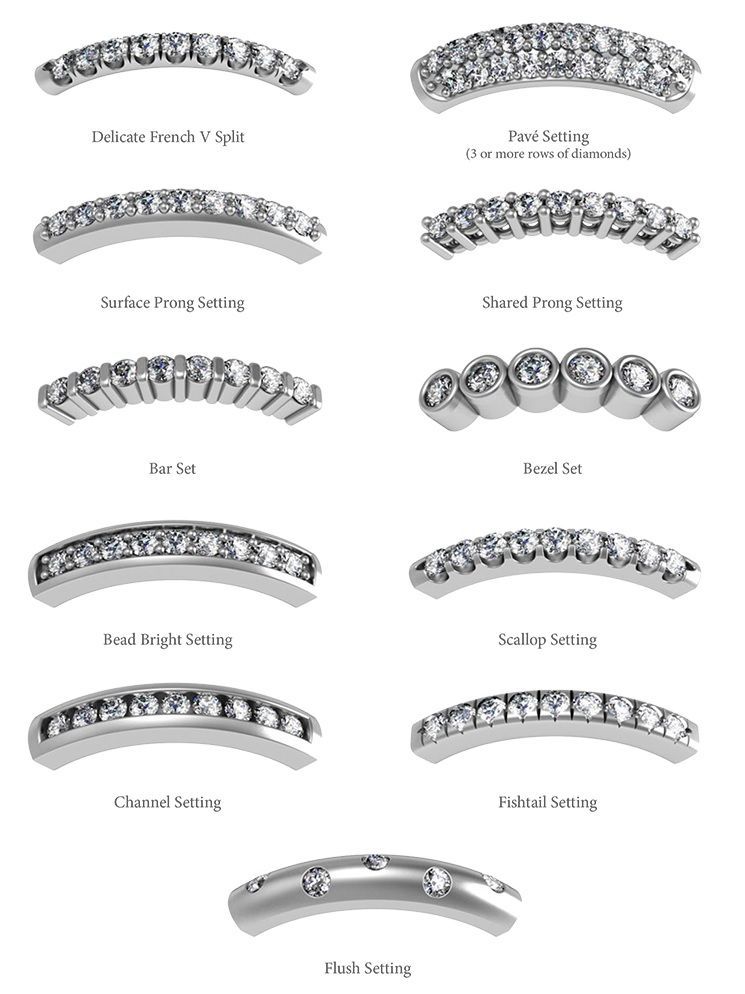
Ring Shank Profiles
The ring shank will have a shape or profile that is most often just to the shoulders of the ring. Sometimes it will go the full circle of the ring. The most popular and well known ring shank profiles are standard Half Round and Comfort Fit, the difference between a standard fit ring and a comfort fit ring is the shape of the inside edge. A standard fit ring has a flat, inner surface, which fits snugly against your finger. A comfort fit ring has a slightly curved inside edge, which allows it to slip on and off more smoothly. There are different levels of a comfort fit ring as shown below.

